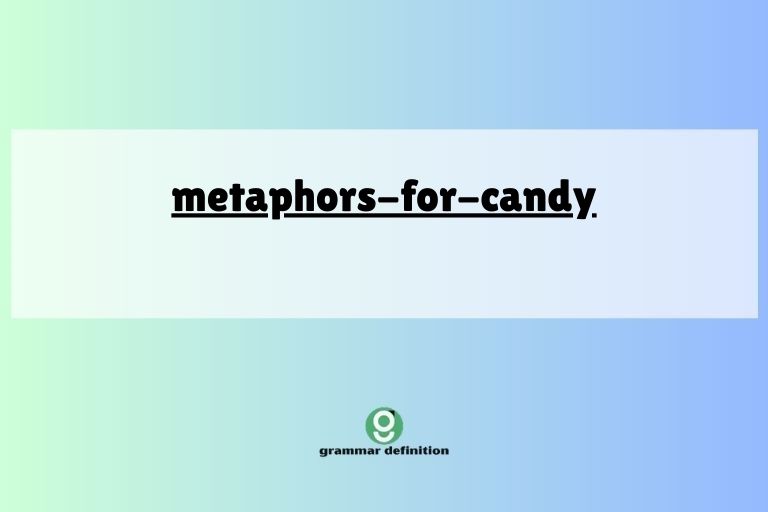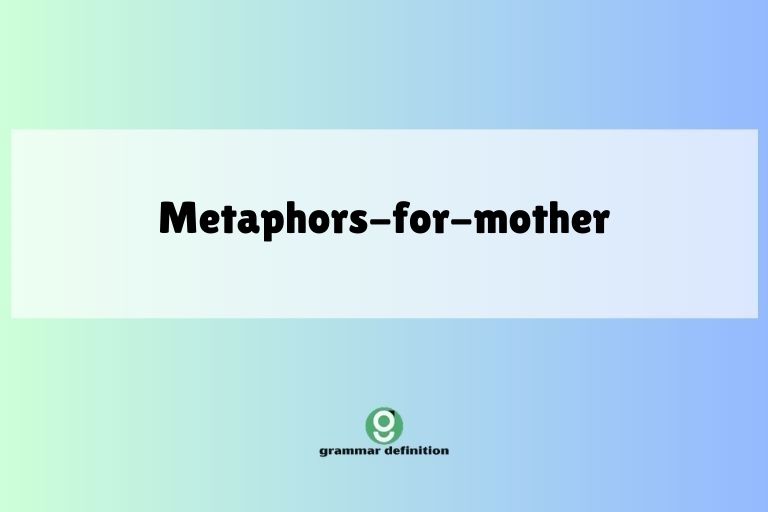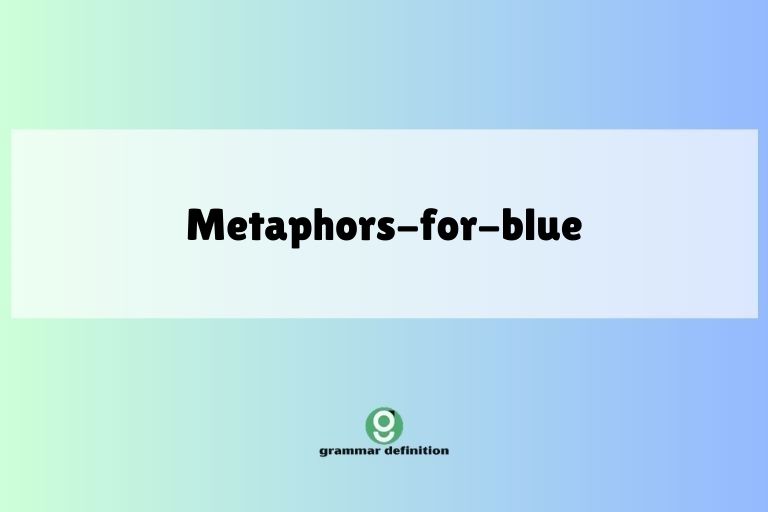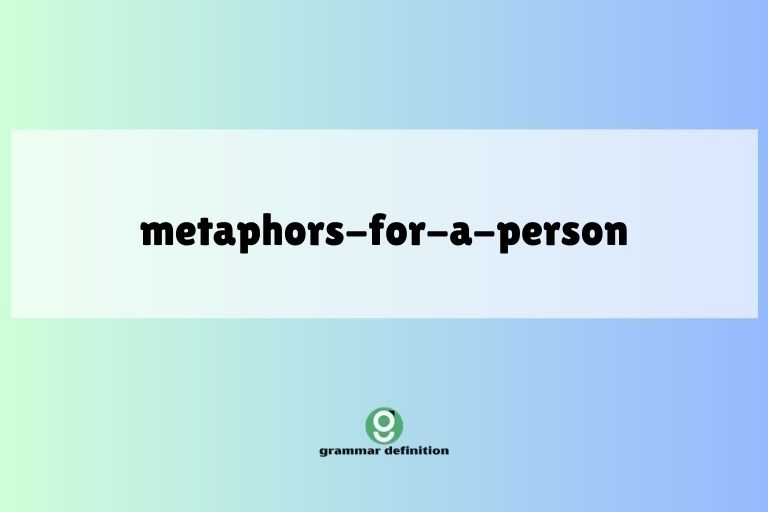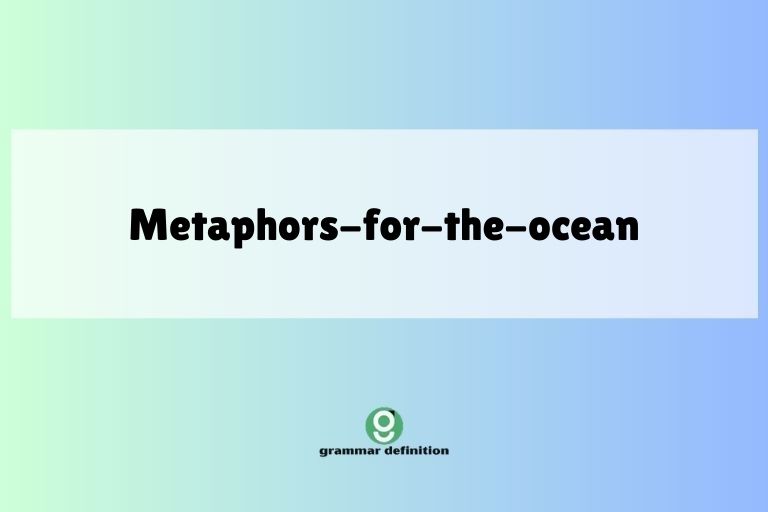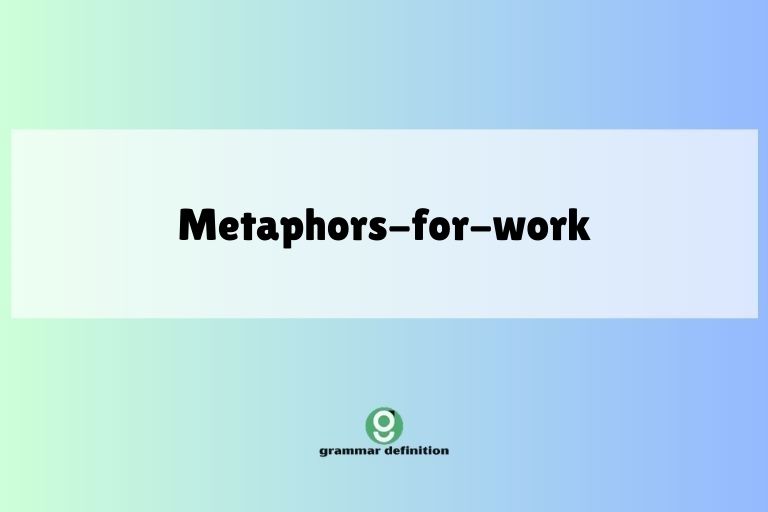Metaphors For Yourself: A Comprehensive Guide
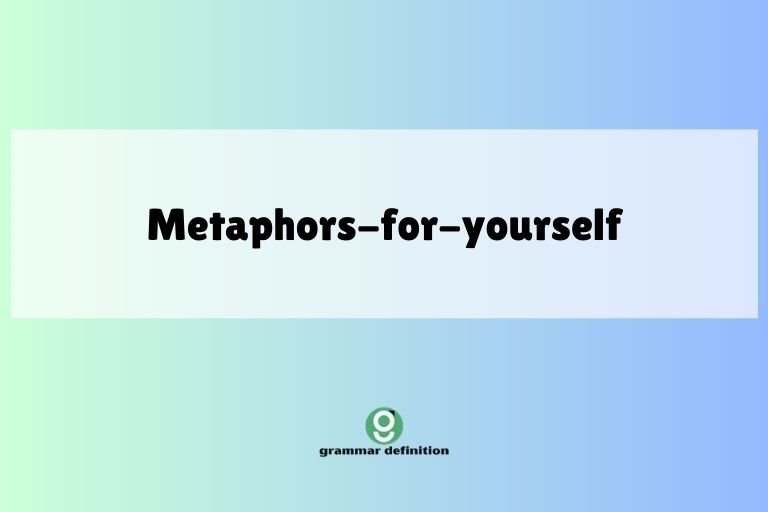
Understanding how to use metaphors to describe yourself is a powerful tool for self-expression and communication. Metaphors allow you to convey complex ideas and emotions in a vivid and relatable way.
This article provides a comprehensive guide to using metaphors for self-description, covering definitions, types, usage rules, common mistakes, and practice exercises. Whether you’re a student, writer, or simply someone looking to enhance your communication skills, this guide will help you master the art of metaphorical self-expression.
By delving into the nuances of metaphorical language, you’ll gain a deeper understanding of how to effectively communicate your personality, experiences, and aspirations. This knowledge will not only improve your writing and speaking abilities but also foster a greater sense of self-awareness and creative expression.
Table of Contents
- Definition of Metaphor
- Structural Breakdown of Metaphors
- Types of Metaphors
- Examples of Metaphors for Yourself
- Usage Rules for Metaphors
- Common Mistakes with Metaphors
- Practice Exercises
- Advanced Topics in Metaphorical Language
- Frequently Asked Questions
- Conclusion
Definition of Metaphor
A metaphor is a figure of speech that directly compares two unrelated things, asserting that one thing is another. Unlike similes, which use words like “like” or “as” to make a comparison, metaphors make a direct equation. The purpose of a metaphor is to create a vivid image or convey a deeper meaning by highlighting shared characteristics between the two seemingly different entities. Metaphors are crucial in literature, poetry, and everyday language, allowing for creative and impactful communication.
In essence, a metaphor transfers qualities or attributes from one subject (the source) to another (the target). This transfer helps the audience understand the target in a new and insightful way.
The effectiveness of a metaphor depends on the relevance and resonance of the comparison. A well-chosen metaphor can transform a mundane description into a powerful and memorable statement.
Structural Breakdown of Metaphors
The structure of a metaphor typically involves two key components: the tenor and the vehicle. The tenor is the subject being described, while the vehicle is the thing to which the tenor is being compared. Understanding these components is essential for crafting effective and meaningful metaphors.
- Tenor: The subject of the metaphor, the thing being described. In the context of “metaphors for yourself,” the tenor is you.
- Vehicle: The object or concept used to describe the tenor. This is the thing that the tenor is being compared to.
- Ground: The shared characteristics between the tenor and the vehicle. This is the basis of the comparison.
For example, in the metaphor “I am a tightly wound spring,” “I” is the tenor, “a tightly wound spring” is the vehicle, and the shared characteristic (the ground) is potential energy, tension, or readiness to act. The effectiveness of the metaphor hinges on the audience’s ability to recognize and understand the ground.
Types of Metaphors
Metaphors come in various forms, each with its unique characteristics and applications. Understanding these different types can help you choose the most appropriate metaphor for your needs.
Implicit Metaphors
An implicit metaphor does not explicitly state the comparison but implies it through suggestive language. The vehicle is present, but the tenor is only hinted at or suggested.
This type of metaphor requires the reader or listener to infer the connection between the two elements.
For instance, instead of saying “I am a storm,” an implicit metaphor might be “The thunder in my heart roared.” The “I” is implied, and the comparison to a storm is conveyed through the imagery of thunder and roaring. Implicit metaphors can be more subtle and require more engagement from the audience.
Explicit Metaphors
An explicit metaphor directly states the comparison between the tenor and the vehicle. This type of metaphor uses clear and direct language, leaving no room for ambiguity.
Explicit metaphors are often easier to understand and can be more impactful due to their directness.
For example, “I am a lighthouse, guiding others through the darkness” is an explicit metaphor. It directly states that “I” am a lighthouse, making the comparison clear and unambiguous.
Explicit metaphors are useful when you want to make a strong and direct statement about yourself.
Extended Metaphors
An extended metaphor is a metaphor that is developed over several lines or even an entire piece of writing. It builds upon the initial comparison, exploring various aspects of the relationship between the tenor and the vehicle.
Extended metaphors allow for a more detailed and nuanced exploration of the subject.
For example, you might start with the metaphor “I am a garden” and then extend it by describing the different plants (representing different aspects of your personality), the soil (representing your foundation), and the gardener (representing your efforts to cultivate yourself). Extended metaphors can create a rich and complex portrait of yourself.
Mixed Metaphors
A mixed metaphor combines two or more incompatible metaphors, often resulting in a nonsensical or humorous effect. While sometimes used intentionally for comedic purposes, mixed metaphors are generally considered a mistake in formal writing.
They can confuse the audience and undermine the clarity of your message.
For example, “I’m going to nip it in the bud and grab the bull by the horns” is a mixed metaphor combining two unrelated idioms. It’s best to avoid mixed metaphors by ensuring that the different elements of your metaphor are consistent and coherent.
Examples of Metaphors for Yourself
Using metaphors to describe yourself can be a powerful way to express your personality, emotions, experiences, and aspirations. Here are some examples categorized by these aspects.
Metaphors for Personality Traits
Metaphors can effectively capture the essence of your personality traits. Consider these examples:
The following table contains examples of metaphors that can be used to describe one’s personality traits. These metaphors provide creative and insightful ways to communicate personal characteristics.
| Personality Trait | Metaphor | Explanation |
|---|---|---|
| Resilient | I am a willow tree, bending but never breaking. | Highlights the ability to withstand challenges and bounce back. |
| Introverted | I am a quiet harbor, where thoughts find refuge. | Conveys a sense of peace and introspection. |
| Extroverted | I am a bustling marketplace, full of energy and interaction. | Represents a vibrant and outgoing personality. |
| Creative | I am a kaleidoscope, constantly shifting and creating new patterns. | Illustrates a dynamic and imaginative mind. |
| Persistent | I am a river, carving my path through stone. | Shows determination and unwavering focus. |
| Empathetic | I am a mirror, reflecting the emotions of others. | Demonstrates the ability to understand and share feelings. |
| Analytical | I am a detective, piecing together the clues. | Represents a methodical and detail-oriented approach. |
| Optimistic | I am a sunrise, always bringing new hope. | Conveys a positive outlook and belief in the future. |
| Independent | I am a lone wolf, forging my own path. | Highlights self-reliance and autonomy. |
| Adaptable | I am a chameleon, blending into new environments. | Shows flexibility and the ability to adjust to change. |
| Disciplined | I am a well-oiled machine, running smoothly and efficiently. | Represents structure and order. |
| Passionate | I am a wildfire, burning with intense enthusiasm. | Conveys strong feelings and dedication. |
| Calm | I am a still lake, reflecting peace and tranquility. | Represents serenity and composure. |
| Curious | I am a moth drawn to a flame, always seeking knowledge. | Highlights a strong desire to learn and explore. |
| Generous | I am a flowing river, giving life to everything around me. | Represents a willingness to share and support others. |
| Organized | I am a meticulously crafted clock, with every gear in its place. | Conveys how someone is structured. |
| Perceptive | I am an owl, watching with keen eyes. | Demonstrates someone has a great observation skills. |
| Confident | I am a lion, standing tall and unafraid. | Highlights someone is brave. |
| Wise | I am an old tree, with rings of knowledge. | Conveys someone has a knowledge. |
| Loyal | I am a compass, always pointing true. | Highlights someone is honest. |
| Patient | I am a mountain, standing tall with grace. | Shows determination and unwavering focus. |
| Determined | I am a lighthouse, guiding others through the darkness. | Demonstrates the ability to understand and share feelings. |
| Creative | I am a detective, piecing together the clues. | Represents a methodical and detail-oriented approach. |
| Joyful | I am a sunrise, always bringing new hope. | Conveys a positive outlook and belief in the future. |
| Kind | I am a lone wolf, forging my own path. | Highlights self-reliance and autonomy. |
Metaphors for Emotions
Emotions can be challenging to describe directly. Metaphors offer a way to express the intensity and complexity of your feelings:
The following table lists metaphors for describing emotions. These metaphors help articulate feelings in a more vivid and imaginative way.
| Emotion | Metaphor | Explanation |
|---|---|---|
| Happiness | I am a sunbeam, warming everything I touch. | Conveys a feeling of joy and positivity. |
| Sadness | I am a rainy day, casting a shadow over everything. | Represents a feeling of gloom and heaviness. |
| Anger | I am a volcano, ready to erupt. | Illustrates intense and explosive emotions. |
| Fear | I am a deer caught in headlights, paralyzed with fright. | Represents a feeling of helplessness and vulnerability. |
| Anxiety | I am a hummingbird, my heart beating too fast. | Conveys a feeling of restlessness and unease. |
| Love | I am a warm hearth, providing comfort and security. | Represents a feeling of warmth, affection, and safety. |
| Jealousy | I am a green-eyed monster, consuming me from within. | Illustrates a feeling of envy and possessiveness. |
| Hope | I am a tiny seed, full of potential. | Represents a feeling of optimism and anticipation. |
| Despair | I am a bottomless pit, sinking into darkness. | Conveys a feeling of hopelessness and emptiness. |
| Excitement | I am a rollercoaster, climbing high and plunging down. | Represents a feeling of thrill and anticipation. |
| Contentment | I am a calm sea, at peace with myself. | Conveys a feeling of peace and fulfillment. |
| Frustration | I am a tangled thread, unable to be untangled. | Illustrates a feeling of annoyance and helplessness. |
| Grief | I am a broken vase, shattered into pieces. | Represents a feeling of loss and sorrow. |
| Loneliness | I am a solitary star, shining alone in the night. | Conveys a feeling of isolation and solitude. |
| Nervousness | I am a tightrope walker, balancing precariously. | Represents a feeling of apprehension and uncertainty. |
| Relief | I am a heavy weight lifted, feeling lighter and free. | Conveys a feeling of release and ease. |
| Awe | I am a star struck child, gazing at the stars. | Demonstrates someone has a great observation skills. |
| Guilt | I am a shadow, lingering in the night. | Highlights someone is brave. |
| Shame | I am an a stone, buried deep under the ocean. | Conveys someone has a knowledge. |
| Disgust | I am a bitter pill, hard to swallow. | Highlights someone is honest. |
| Surprise | I am a jack in the box, popping up unexpectedly. | Shows determination and unwavering focus. |
| Boredom | I am a blank canvas, waiting for inspiration. | Demonstrates the ability to understand and share feelings. |
| Confusion | I am a maze, unable to find my way out. | Represents a methodical and detail-oriented approach. |
| Embarrassment | I am a spotlight, shining directly on my mistakes. | Conveys a positive outlook and belief in the future. |
| Yearning | I am a sunflower, always turning towards the sun. | Highlights self-reliance and autonomy. |
Metaphors for Experiences
Life experiences shape who we are. Use metaphors to describe significant events and their impact:
The following table provides metaphors for describing life experiences. These metaphors capture the essence of significant events and their impact on personal growth.
| Experience | Metaphor | Explanation |
|---|---|---|
| Overcoming Adversity | I am a phoenix, rising from the ashes. | Conveys resilience and the ability to overcome challenges. |
| Learning a Lesson | I am a student, absorbing knowledge from every experience. | Represents the ongoing process of learning and growth. |
| Facing a Challenge | I am a mountain climber, scaling new heights. | Illustrates determination and the pursuit of goals. |
| Finding Love | I am a blooming flower, blossoming in the sunlight. | Represents growth and happiness. |
| Losing a Loved One | I am a ship without a sail, lost at sea. | Conveys a feeling of loss and disorientation. |
| Starting a New Job | I am a blank slate, ready to be filled with new experiences. | Represents a fresh start and new opportunities. |
| Moving to a New City | I am a tree being transplanted, adapting to new soil. | Illustrates the process of adjustment and growth in a new environment. |
| Graduating | I am a bird, leaving the nest. | Represents a the freedom. |
| Getting Married | I am a river, joining another. | Conveys a feeling of loss and disorientation. |
| Having a Child | I am a tree, bearing fruit. | Represents a fresh start and new opportunities. |
| Retiring | I am a book, closing my pages. | Illustrates the process of adjustment and growth in a new environment. |
| Traveling | I am a rolling stone, gathering no moss. | Conveys a feeling of peace and fulfillment. |
| Writing a Book | I am an architect, building a new world. | Illustrates a feeling of annoyance and helplessness. |
| Starting a Business | I am a seed, planted in the ground. | Represents a feeling of loss and sorrow. |
| Buying a House | I am a turtle, finding my shell. | Conveys a feeling of isolation and solitude. |
| Volunteering | I am a hand, reaching out to help others. | Represents a feeling of apprehension and uncertainty. |
| Making a Mistake | I am a stain, hard to remove. | Conveys a feeling of release and ease. |
| Making a Friend | I am a puzzle, finding a matching piece. | Demonstrates someone has a great observation skills. |
| Losing a Job | I am a kite, with no string. | Highlights someone is brave. |
| Winning an Award | I am a star, shining bright. | Conveys someone has a knowledge. |
| Failing an Exam | I am a broken pencil, unable to write. | Highlights someone is honest. |
| Learning to Drive | I am a driver, learning to control the car. | Shows determination and unwavering focus. |
| Learning to Play a musical intrument | I am a musician, learning to play the instruments. | Demonstrates the ability to understand and share feelings. |
| Discovering a Hobby | I am a cat, finding a new toy to play with. | Represents a methodical and detail-oriented approach. |
| Adopting a Pet | I am a house, finding a loving family. | Conveys a positive outlook and belief in the future. |
| Learning a New Language | I am a child, learning to speak new words. | Highlights self-reliance and autonomy. |
Metaphors for Aspirations
Express your dreams and goals through metaphorical language:
The following table includes metaphors for expressing aspirations. These metaphors capture the essence of personal dreams and goals.
| Aspiration | Metaphor | Explanation |
|---|---|---|
| Achieving Success | I am a rocket, soaring to new heights. | Conveys ambition and the pursuit of goals. |
| Making a Difference | I am a ripple, creating waves of change. | Represents the desire to have a positive impact. |
| Finding Inner Peace | I am a mountain top, untouched by the chaos below. | Illustrates the pursuit of tranquility and serenity. |
| Becoming a Leader | I am a shepherd, guiding my flock. | Represents the desire to lead and inspire others. |
| Creating Something Beautiful | I am an artist, painting a masterpiece. | Conveys the desire to create and express oneself. |
| Gaining Knowledge | I am a sponge, absorbing all that I can. | Represents the pursuit of learning and understanding. |
| Building a Legacy | I am an architect, designing a lasting structure. | Illustrates the desire to leave a positive impact on future generations. |
| Finding Love | I am a magnet, finding my partner. | Represents a the freedom. |
| Becoming a Parent | I am a gardener, raising a new generation. | Conveys a feeling of loss and disorientation. |
| Achieving Financial Freedom | I am a bird, flying away from the cage. | Represents a fresh start and new opportunities. |
| Writing a Novel | I am a worldbuilder, creating a new universe. | Illustrates the process of adjustment and growth in a new environment. |
| Traveling the World | I am a explorer, searching for new lands. | Conveys a feeling of peace and fulfillment. |
| Starting a Charity | I am a giver, helping those in need. | Illustrates a feeling of annoyance and helplessness. |
| Becoming a Teacher | I am a candle, lighting the way for others. | Represents a feeling of loss and sorrow. |
| Learning a New Skill | I am a craftsman, honing my skills. | Conveys a feeling of isolation and solitude. |
| Improving My Health | I am a plant, growing strong. | Represents a feeling of apprehension and uncertainty. |
| Building a Home | I am a bird, making a nest. | Conveys a feeling of release and ease. |
| Starting a Business | I am an architect, building a sky scrappers. | Demonstrates someone has a great observation skills. |
| Writing a Poem | I am a writer, writing a beautiful words. | Highlights someone is brave. |
| Learning a New Sport | I am an atlethe, achieving the goals. | Conveys someone has a knowledge. |
| Buying a Car | I am a traveller, finding a vehicle. | Highlights someone is honest. |
| Getting a Pet | I am an animal lover, finding a new friend. | Shows determination and unwavering focus. |
| Forgiving Someone | I am a healer, mending broken heart. | Demonstrates the ability to understand and share feelings. |
| Apologizing to Someone | I am a person, asking for forgiveness. | Represents a methodical and detail-oriented approach. |
| Making Peace with the Past | I am a historian, learning from the past. | Conveys a positive outlook and belief in the future. |
| Letting Go of Anger | I am a leaf, falling from a tree. | Highlights self-reliance and autonomy. |
Usage Rules for Metaphors
Using metaphors effectively requires adherence to certain rules. These guidelines ensure that your metaphors are clear, impactful, and appropriate.
- Clarity: Ensure that the connection between the tenor and the vehicle is clear. The audience should be able to understand the basis of the comparison without confusion.
- Relevance: Choose vehicles that are relevant to the tenor and the context. The comparison should make sense and enhance the meaning of your message.
- Originality: Strive for originality in your metaphors. Avoid clichés and overused comparisons. A fresh and creative metaphor will have a greater impact.
- Consistency: Maintain consistency within your metaphors. Avoid mixing metaphors that create conflicting or nonsensical images.
- Appropriateness: Consider the audience and the tone of your writing. Choose metaphors that are appropriate for the occasion and the intended audience.
By following these usage rules, you can ensure that your metaphors are effective and enhance your communication.
Common Mistakes with Metaphors
Several common mistakes can undermine the effectiveness of metaphors. Being aware of these pitfalls can help you avoid them.
The following table highlights common mistakes made when using metaphors, along with examples of incorrect and correct usage.
| Mistake | Incorrect Example | Correct Example |
|---|---|---|
| Mixed Metaphor | I’m going to grab the bull by the horns and nip it in the bud. | I’m going to seize the opportunity and take decisive action. |
| Cliché Metaphor | I am as busy as a bee. | I am a whirlwind, juggling multiple tasks. |
| Unclear Metaphor | I am a color. | I am a vibrant blue, calm and steady. |
| Inappropriate Metaphor | Describing a funeral with a metaphor about celebration. | Describing a funeral with a metaphor about sorrow and loss. |
| Overused Metaphor | Life is a journey. | Life is a winding road, full of unexpected turns and breathtaking vistas. |
Practice Exercises
Test your understanding of metaphors with these practice exercises. Identify the type of metaphor, or create your own metaphors for the given prompts.
The following exercise provides questions to test your understanding of metaphors, along with their corresponding answers.
| Question | Answer |
|---|---|
| Create a metaphor to describe yourself as a student. | I am a sponge, soaking up knowledge. |
| Identify the type of metaphor: “I am a rock, solid and unyielding.” | Explicit metaphor. |
| Correct the mixed metaphor: “Let’s table that idea and put it on the back burner.” | Let’s postpone that idea for later consideration. |
| Create a metaphor to describe your biggest fear. | I am a bird, trapped in the cage. |
| Identify the type of metaphor: “The fire in my belly burned.” | Implicit metaphor. |
| Create a metaphor to describe your hometown. | I am a small town, close net community. |
| Create a metaphor to describe your favorite hobby. | I am a painter, finding a new hobby. |
| Create a metaphor to describe your perfect day. | I am a sun, shining brightly. |
| Create a metaphor to describe your dream job. | I am an architect, building a new building. |
| Create a metaphor to describe your ideal partner. | I am a magnet, finding my partner. |
Advanced Topics in Metaphorical Language
For advanced learners, exploring the theoretical underpinnings of metaphors can provide a deeper understanding of their power and function.
- Conceptual Metaphor Theory: This theory proposes that metaphors are not just linguistic devices but fundamental cognitive structures that shape our understanding of the world.
- Metaphor and Cognition: Explore how metaphors influence our thinking, perception, and decision-making processes.
- Cultural Metaphors: Investigate how metaphors vary across cultures and reflect different values and beliefs.
Delving into these advanced topics can enhance your ability to use metaphors in sophisticated and impactful ways.
Frequently Asked Questions
Here are some frequently asked questions about metaphors:
- What is the difference between a metaphor and a simile?
A metaphor directly equates two unlike things, while a simile uses “like” or “as” to make a comparison. For example, “I am a lion” is a metaphor, whereas “I am like a lion” is a simile.
- How can I create original metaphors?
To create original metaphors, think about the qualities or characteristics of the thing you want to describe, and then brainstorm other things that share those qualities. Look for unexpected connections and try to express them in a fresh and creative way.
- What makes a metaphor effective?
An effective metaphor is clear, relevant, and original. It should create a vivid image or convey a deeper meaning that resonates with the audience.
- Can a metaphor be too complex?
Yes, a metaphor can be too complex if the connection between the tenor and the vehicle is too obscure or convoluted. The audience should be able to understand the comparison without excessive effort.
- Is it okay to use clichés in metaphors?
While clichés can be easily understood, they lack originality and impact. It’s generally better to avoid clichés and strive for fresh and creative metaphors.
- How do metaphors enhance communication?
Metaphors enhance communication by making abstract ideas more concrete, creating vivid images, and conveying deeper meanings. They can also make your writing or speaking more engaging and memorable.
- What role do metaphors play in literature?
Metaphors are a fundamental element of literature, adding depth, complexity, and beauty to writing. They allow writers to explore complex themes, create memorable characters, and evoke powerful emotions.
- How can I improve my ability to use metaphors?
To improve your ability to use metaphors, read widely, pay attention to the metaphors used by others, and practice creating your own metaphors. Experiment with different types of metaphors and seek feedback on your work.
Conclusion
Mastering the art of using metaphors for self-description is a valuable skill that enhances communication and self-expression. By understanding the definition, structure, types, and usage rules of metaphors, you can effectively convey your personality, emotions, experiences, and aspirations in a vivid and memorable way.
Avoiding common mistakes and practicing regularly will further refine your abilities.
Embrace the power of metaphorical language to unlock new depths of self-awareness and creative expression. Continue to explore the theoretical underpinnings of metaphors and experiment with different techniques to elevate your communication skills.
With practice and dedication, you can become a master of metaphorical self-expression.

